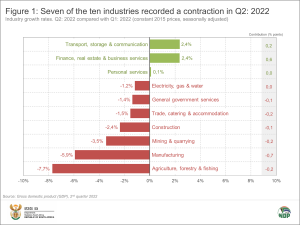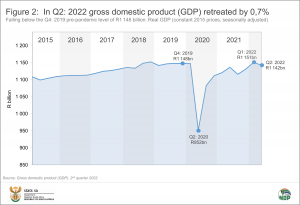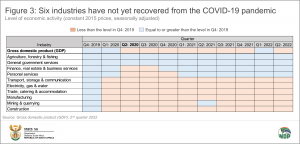South African GDP declines by 0,7%
After two consecutive quarters of positive growth, real gross domestic product (GDP) decreased by 0,7%1 in the second quarter of 2022 (Q2: 2022). The devastating floods in KwaZulu-Natal and load shedding contributed to the decline, weakening an already fragile national economy that had just recovered to pre-pandemic levels.
Manufacturing the biggest drag on GDP
The flooding had a negative impact on a number of industries, most notably manufacturing.
Manufacturing is the largest industry in KwaZulu-Natal, according to 2019 data, accounting for a fifth of national manufacturing production.2 The damage to factories and plants, and disruptions to logistics and supply chains, pulled national manufacturing output down by 5,9% (Figure 1). The biggest drags on growth were petroleum and chemical products, food and beverages, and transport equipment.
Trade, catering & accommodation was negatively impacted by both the floods in KwaZulu-Natal and power cuts across the country. The industry recorded a contraction of 1,5% as floods damaged retail outlets and storage facilities. There was also a loss of trading hours due to load shedding.
Mining production was dragged lower by gold, coal and diamonds, with the decrease in coal production caused partly by the flooding. Mining output was also negatively affected by load shedding.
Economic activity in the electricity, gas & water supply industry was hampered mainly by load shedding due to lack of generation capacity. There were disruptions to water supply too, caused by both the floods in KwaZulu-Natal and drought in Eastern Cape.
Agriculture, forestry & fishing activity decreased by 7,7%, pulled lower by a decrease in the production of animal products. Electricity outages and the spread of foot-and-mouth disease contributed to the decline.
On the upside, the finance, real estate & business services industry made the biggest positive impact on GDP growth in Q2: 2022, rising by 2,4%. Growth was driven by increased activity in the banking sector, as well as in insurance and pension funding.
Economic recovery from COVID-19: Not all industries are equal
The economy took almost two years to recover from the impact of COVID-19, with real GDP reaching pre-pandemic levels in Q1: 2022 (Figure 2). The recovery was short lived, with the 0,7% decline in Q2: 2022 dragging GDP back below the Q4: 2019 pre-pandemic level of R1 148 billion.
The story of recovery is more complicated when we consider the industries. Adopting the same methodology used in a recent article that compared South Africa’s COVID-19 recovery with other countries3, Figure 3 shows how long each industry took to recover to its Q4: 2019 level, from Q2: 2020 when national economic activity was at its lowest.
By Q2: 2022, only four industries were at or above their pre-pandemic levels of production. After slumping in Q2: 2020, the finance, real estate & business services industry took two quarters to recover to its Q4: 2019 level, while personal services took three quarters to get back on its feet.
In terms of this indicator (real value added), agriculture, forestry & fishing and government seem to have weathered the pandemic relatively well.
Six industries have not yet recovered, with construction currently in the worst shape. The construction industry is 24% smaller than it was before the pandemic. Mining briefly recovered in Q2: 2021 but has since remained below its Q4: 2019 level.
For more information, download the latest GDP release, media presentation and Excel files here.
1 The quarter-on-quarter rates are seasonally adjusted and in real (volume) terms (constant 2015 prices).
2 Stats SA, Quarterly and Regional Fourth_quarter 2020 Excel file, Tables 21b and 28b (download here).
3 Stats SA, Economic recovery from COVID-19: Not all countries are equal (read here).
Similar articles are available on the Stats SA website and can be accessed here.




